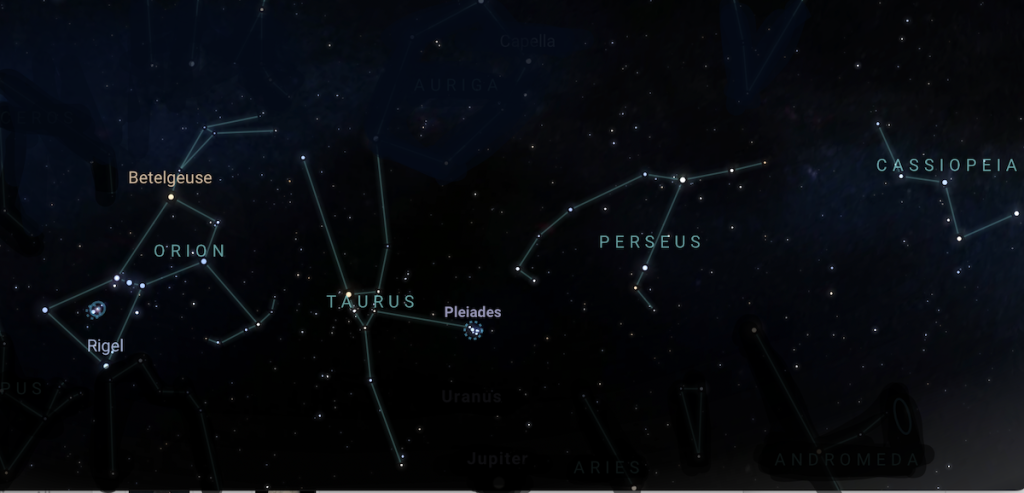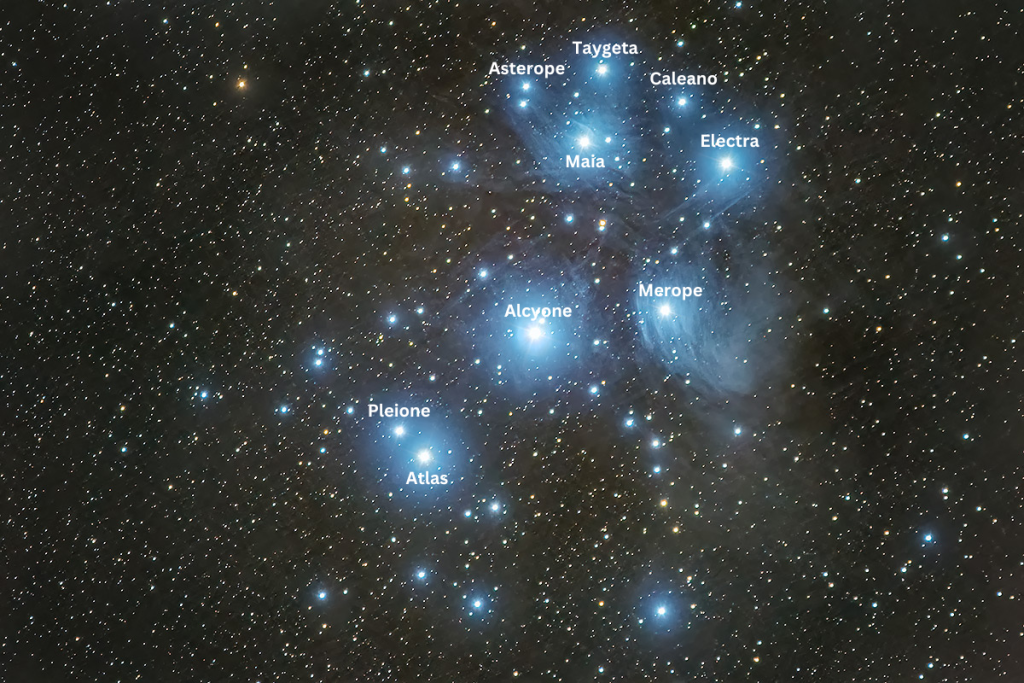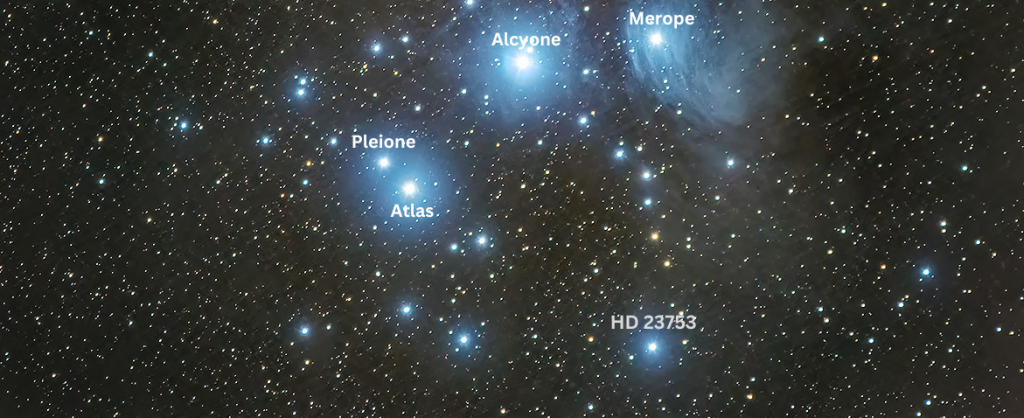For centuries, the Pleiades star cluster has captured the imaginations of skywatchers, poets, and astronomers alike. Often referred to as the “Seven Sisters”, this luminous cluster of stars is one of the closest and most easily visible clusters from Earth.
The Pleiades star cluster can be best observed during the fall and winter months in the Northern Hemisphere or spring/summer in the Southern Hemisphere. The Pleiades’ location near the celestial equator and on the ecliptic means that the cluster is visible from just about anywhere on Earth except Antarctica, and for most people in the Northern Hemisphere, the Pleiades can reach high into the sky or even appear directly overhead.
By late October and into November, the cluster rises in the east just after sunset and continues its ascent, reaching its highest point in the sky during the late evening hours. As the months progress, the Pleiades rise earlier and earlier each evening before sinking into the glow of the Sun by mid-April and re-emerging low in the dawn sky in late July.
The Pleiades reside within the zodiac constellation of Taurus. The Pleiades and Taurus are situated roughly midway between the constellations Cassiopeia and Orion. If you’re familiar with these prominent fall/wintertime constellations, you can use them as landmarks to guide your eyes to the desired spot in the sky.

Once you’ve found Aldebaran, which is the brightest star in Taurus and represents the bull’s eye, the Pleiades cluster is roughly to the northwest of this star. If you think of Taurus as a V-shaped pattern of stars, with Aldebaran at the tip, the Pleiades will sit on the top-right side of this ‘V’. If you can’t find Aldebaran, try first spotting the constellation Orion, particularly its three-star belt. Extend a line from this belt, and you’ll reach Aldebaran; you’ll find the Pleiades sitting just beyond, a bit further along the line.
The Pleiades star cluster is visible to the naked eye from most locations, especially those with clear, dark skies. However, while most people can discern five to ten stars of the Pleiades with the naked eye, using a pair of binoculars will reveal many more stars and make it much easier to spot the fainter members of the star cluster. The cluster’s stars all sparkle with a cool blue hue, a result of their extremely high temperatures.
Occasionally, the Moon and planets can pass near the Pleiades star cluster or even through the cluster, as a result of the cluster’s location near the ecliptic plane on which the planets orbit the Sun. The Moon will largely wash out the cluster, but watching individual stars dip behind it and re-emerge or just graze the northern or southern edges of our nearest satellite (what’s known as an occultation) can be a thrilling experience. Likewise, it’s a stunning sight to witness the planets—particularly bright Venus, Mars, or Jupiter—appearing to reside amidst the sparkling members of the cluster.
Spotting the Pleiades Cluster with the Unaided Eye

Seven naked-eye visible stars in the Pleiades star cluster are named after the daughters of Atlas and Pleione from Greek mythology, though the naked-eye visible stars in the cluster also include two additional members (named Atlas and Pleione themselves). The six most prominent members (Alycone, Atlas, Electra, Maia, Merope, and Taygeta) make up a miniature Big Dipper asterism in the sky, which is readily apparent from all but the most brightly lit city centers. Most people are used to being able to discern 8 or 9 stars in the cluster with the naked eye; in fact, well over a dozen are easy to see from a rural location, and in total, around 30–40 members of the Pleiades star cluster can technically be seen without optical aid.
The “Seven” (actually 9 or 10) Sisters
- Alcyone, or Eta Tauri, is the most radiant among the young, bright stars of the Pleiades as seen from Earth, with an apparent magnitude of 2.86. Alcyone boasts a luminosity nearly 2,400 times that of our Sun.
- Atlas (27 Tauri), with a magnitude of 3.62, is a fitting tribute to the Titan known to hold the skies in myth and sits at the tail of the miniature dipper asterism that the Pleiades resemble. The star is a triple star system, with its primary component gleaming as a blue-white giant.
- Electra, or 17 Tauri, is another standout with a magnitude of 3.70. This blue giant also exhibits a high rotation speed.
- Maia (20 Tauri) has a magnitude of 3.87. What makes Maia unique is the denser surrounding reflection nebula, the only portion with an NGC designation (NGC 1432).
- Merope (23 Tauri) gleams with a magnitude of 4.17 and is surrounded by a distinct reflection nebula, separate from Maia’s.
- Taygeta (19 Tauri) shines with an apparent magnitude of 4.29.
- Pleione (BU Tauri) holds significance as the mother of the Seven Sisters in mythology. Pleione sits just next to Atlas and is a variable star, shining at magnitude 4.77 at its brightest and 5.5 at its dimmest. Pleione is a Gamma Cassiopeiae type variable; it rotates extremely quickly, so fast that it occasionally ejects material, leading to a disk of matter blocking some of its light. Pleione’s proximity to Atlas and significantly lower apparent magnitude than preceding members mean that observers with less-than-sharp eyesight or severe light pollution will often miss Pleione and only identify six “sisters” in the Pleiades.
- Celaeno (16 Tauri), with a magnitude of 5.44, sits between Maia and Electra, making it fairly easy to identify under a darker sky.
- Dimmer still is Sterope (21 & 22 Tauri). Sterope is a wide binary system about 3 arc minutes apart, with magnitude 5.76 and 6.43 blue giant components. Eagle-eyed viewers will be able to spot the two stars just barely separated from each other under a clear, dark sky.
If you’re confused, yes, the aforementioned named stars add up to ten in all, though Sterope was easily mistaken for a single star by pre-telescopic observers, meaning that there are, in fact, still only seven named sisters. However, these are not the only stars in the cluster that can be seen with the naked eye.

Funnily enough, HD 23753 and 18 Tauri, despite lacking mythological names, are easier to spot than either component of Sterope, separated more widely from the other stars in the Pleiades and shining at apparent magnitudes of 5.44 and 5.66, respectively. Even under a somewhat light-polluted sky, this means that you should be able to count somewhere between nine and fourteen stars in the Pleiades with your unaided eye. HD 23985, HD 23923, HD 23712, HD 24368, HD 24213, and HD 23873 are all also members of the cluster but are around sixth magnitude; a dozen or so additional stars brighter than magnitude 7.5 and separated sufficiently from other members of the cluster can also be spotted by experienced astronomers under a very dark sky, adding up to a total of over thirty “sisters” in the Pleiades!
Viewing The Pleiades Star Cluster through Telescopes & Binoculars
For many amateur astronomers, binoculars are the first tool of choice when gazing upward. They’re cheap, portable, and provide a wider field of view than most telescopes can. When trained on the Pleiades, even a pair of 7×35 binoculars can truly transform the observing experience. First and foremost, the density of stars becomes immediately apparent. While the naked eye might discern a couple dozen stars on a clear night at best, binoculars or even a small telescope should reveal the Pleiades to contain a dense swarm of hundreds of glittering points, even from the suburbs. Binoculars or a telescope will also bring out the subtle color differences in the brightest members of the star cluster, though the young and massive stars of the Pleiades are almost always blue or white in hue, not a rainbow of colors like many other prominent telescopic open clusters.
Larger telescopes are arguably a poor choice for viewing the Pleiades, as the cluster spans about two degrees, or four full Moons across, on the long axis. The best views are with smaller, wide-field instruments that show the cluster as well as some space around the stars. This makes it easier to see the reflection nebula enclosing the Pleiades. A telescope reveals hundreds of stars sprinkled throughout the cluster.
Under dark skies with larger binoculars or a small telescope, a bluish haze around some of the Pleaides’ stars, especially around Merope and Maia, becomes more evident. This is the reflection nebula—the interstellar dust reflecting the blue light of the young, hot Pleiades stars. A 6” or larger aperture under a sufficiently dark sky should reveal the nebulosity of the cluster at low powers, even if you cannot discern it with a smaller instrument. The easiest way to start looking for the wispy threads of gas and dust interspersed in the cluster is to start at Merope. The brightest portion of the Pleaides’ reflection nebula is centered on Merope and appears as a fan- or coma-shaped glow pointing out and away from the other stars in the cluster. You can easily mistake it for glare or internal reflections in your telescope/eyepiece. Try moving the telescope around slightly; if the glow appears to stay in place relative to Merope, you’ve spotted the nebula.
Depending on your sky conditions, you may be able to trace further nebulosity outward from Merope in a loop around the western stars of the cluster, ending at Maia. If this portion is easy to spot with your telescope, you should be able to discern an even fainter, more wispy portion of the nebula going around the tail end of the cluster towards Atlas/Pleione, trailing off into a huge, barely-visible bubble of nebulosity enclosing the entire Pleiades; this bubble is about 3 or 4 degrees across in all.
